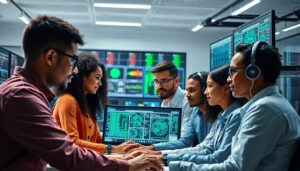Imagine a world where computers can “see” and understand images like humans do. That is the power of computer vision—it is transforming how we interact with technology. Google is at the forefront, leading the charge with innovative tools and applications. This article explores computer vision with Google. We will see how it works and what it can do.
Understanding the Fundamentals of Computer Vision
Let’s break down the basics of computer vision. We will look at how it connects to Google’s powerful tools.
What is Computer Vision?
Computer vision allows computers to interpret and understand images. Image recognition helps identify objects in photos. Object detection finds specific elements. Image segmentation divides a picture into parts. These are all key computer vision concepts. Google uses these in many of its services.
How Computer Vision Works: A Simplified Overview
How does a computer “see”? First, it processes an image. Then, it extracts important features like edges and shapes. Finally, machine learning algorithms help it recognize what it is seeing. This process helps Google identify objects in a picture.
The Role of Machine Learning and Deep Learning
Machine learning (ML) and deep learning (DL) are crucial. They help computers learn from data. CNNs (Convolutional Neural Networks) are important DL tools. They are used to analyze images. These algorithms power much of Google’s computer vision.
Google Computer Vision Technologies and Platforms
Google provides several computer vision technologies. Let’s explore some of them.
TensorFlow and Keras for Computer Vision
TensorFlow and Keras are essential frameworks. They help build and deploy computer vision models. TensorFlow is powerful. Keras makes development easier. Many developers use them for computer vision tasks. These tools make computer vision solutions accessible quickly.
Google Cloud Vision API
The Cloud Vision API is a powerful tool. It offers image labeling. It can detect faces. It also features OCR (Optical Character Recognition). This API is very useful for developers. You can use it to analyze images in the cloud.
AutoML Vision
AutoML Vision simplifies model building. You don’t need a lot of expertise. It helps you create custom computer vision models. AutoML makes it easier to get started. This is great for people new to computer vision.
Real-World Applications of Google Computer Vision
Google computer vision tools have many applications. Let’s look at some real-world uses.
Enhancing Search Experience and Organization
Computer vision improves Google Search. It also boosts Google Photos features. Search becomes smarter. Organization gets better. It makes finding that one particular photo easier.
Improving Accessibility
Computer vision assists people with visual impairments. Apps can describe scenes aloud. This technology can make a big difference. It offers more independence.
Computer Vision in Healthcare
Google CV tools could help diagnose diseases. They can analyze medical images. This could improve treatment. It provides faster insights for doctors.
Getting Started with Computer Vision on Google Cloud
Want to try computer vision? Here are steps to get started on Google Cloud.
Setting Up a Google Cloud Account
First, create a Google Cloud account. Then, enable the Vision API. You need a billing account too. It’s pretty simple to do.
Exploring the Cloud Vision API: A Hands-on Example
Here’s a quick example. Use the API to label an image. Upload an image to Cloud Storage. Then, use the API to detect labels. You’ll see how it identifies objects.
Best Practices for Optimizing Performance and Cost
Use smaller images for faster processing. Cache results to save money. Choose the right API features. These tips keep costs low. They also improve performance.
The Future of Computer Vision with Google
What’s next for computer vision? Google is always innovating.
Advancements in AI and Deep Learning
AI and deep learning are always improving. This drives new computer vision capabilities. Expect even more powerful tools. It opens doors for new possibilities.
Ethical Considerations and Responsible AI
Ethical challenges are important. Google focuses on responsible AI. This means fairness and privacy. The goal is to build trustworthy systems.
Conclusion
Google plays a huge role in computer vision. Its tools are accessible and powerful. Now, it’s your turn to experiment with it. See what amazing things you can create.



